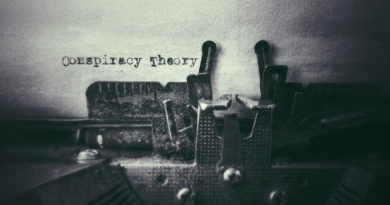QAnon: how the far-right cult took Australians down a ‘rabbit hole’ of extremism
Cam Smith, an Australian researcher who monitors online far-right activity, had first noticed mention of QAnon in the local communities he watched as early as 2018. At the time, it looked like just a few “tiny meetup groups on Facebook” of around 20 people, he told me. “They were talking about, ‘Oh, we’ll meet up at like some pub in Oakleigh, and we’ll talk about this QAnon thing.’ And I didn’t think it was going to be that important.”
Smith’s interest in the local movement was sparked again during the periods of heavy coronavirus public health restrictions in Melbourne, in 2020. To contain an outbreak of the virus within Melbourne’s public housing high-rise towers, local authorities had moved quickly – and controversially – to unilaterally lock down the residential communities in the buildings. In defiance of the restrictions, a group of QAnon believers drove nearly 2,000km from Queensland to protest against the events, filming themselves – and expounding their theories – as they went.
Smith was curious, found a way into their Facebook groups and started tracking their conversations. What he noticed was that Facebook’s algorithm was assisting the spread of disturbing content. Smith found that even engagements with Australian Facebook groups that represented softer political positions – like a small anti-vaccine community – quickly pushed him towards extremist content. “The Facebook algorithm was like, ‘I know some other stuff you would be interested in!’” Smith says, and it drove users within Australia’s shallow Facebook pool towards political content that was much more hardcore.
As had happened in Germany, QAnon seeded its Australian iteration through the networks of the wellness community. It was a bourgeois place in which those fearful of “precarity” came to seek comfort. Community values here lay in promoting opportunities for personal healing through “clean eating” and radical diets, alternative medicine, meditation, yoga and new age beliefs. It was also a place where anti-vax conspiracy theories had lurked for some time, and, as the pandemic progressed, became a ripe channel – online and off – for QAnon influence. A personal friend described to me how her first encounter with QAnon belief in Australia resulted from a “rabbit hole” opening for her on Facebook while she searched recommendations of organic food for her dog.
Guardian columnist Brigid Delaney – whose 2017 book, Wellmania, charted her adventures through the wellness industry – wrote about the emerging alliance she saw between the wellness and conspiracist communities in a 2020 piece. Here she revisited a concept first explained in the 1990s by Michael Kelly in the New Yorker. Kelly had called it “fusion paranoia”, and described it as the process of strengthening and bonding that takes place between unalike movements when they recognise they share a core belief. During coronavirus lockdowns, wrote Delaney, this shared core belief was the idea that the virus was “a cover for a plot of totalitarian proportions, designed to stifle freedom of movement, assembly, speech and – to the horror of some in the wellness industry – enforce a program of mass vaccinations”.

By 2021, those wanting to believe that QAnonism had mostly spared isolated Australia had an increasing amount of evidence to ignore. Australia’s experience of the coronavirus pandemic between 2020 and 2021 was dominated by a series of rolling lockdowns that trapped Australians at home with a lot of frustration – and the internet – for months at a time. The preponderance of anecdotal accounts detailing encounters with QAnon online could be written off as unrepresentative of what may have been going on in the broader community. Accumulating statistics, however, were a far harder boulder to shift.
A 2020 paper released by the British-based thinktank the Institute for Strategic Dialogue revealed that, after the US, Britain and Canada, Australia was the fourth-largest producer of QAnon content worldwide. Australia created more QAnon content than Russia.
Shockingly, this had been so even before the pandemic, with Australians sharing more than 105,000 QAnon tweets in the first nine months of the theory’s existence between October 2017 and June 2018. QAnon researcher Marc-André Argentino was monitoring QAnon activity on 8kun and recorded the presence of six Australian QAnon research boards there in January 2020, hosting 4,000 posts. By the start of 2021, the number of research boards had grown to 11.
In a February 2021 feature journalist Michael McGowan noted that QAnon’s unique ability to cross-pollinate with other conspiracy theories had created fusion paranoia in Australia, not only with anti-vax communities but also anti-lockdown protesters and anti-migration and antisemitic tropes as well as the community of anti-5G mobile phone tower activists. This was not an inconsiderable number of Australians to influence. Polling from Essential Media revealed a shocking 12% of Australians believed 5G towers were being used to spread coronavirus.
What lay behind all of these statistics of tweets and cross-pollination and web centipedes and influence were the sad true stories of Australians mourning the loss of loved ones to “the Qult” in places like Reddit’s r/QAnonCasualities community. Statistics could measure the size of QAnon’s transmission into Australia, but the unquantifiable anecdotes recorded its cost. QAnon cultism was not a phenomenon that just affected abstracted, faraway people on the internet. It was getting into families, and communities. It was hurting workplaces and friendship groups. Including mine.
Meshelle and the cults
My friend Meshelle – not her real name – had already had a negative encounter with another cult, many years before QAnon inserted itself in her life. She’d met her partner, Dave, straight out of high school in Brisbane. Married more than 20 years, they had two teenage kids and long-term jobs when Meshelle started to suffer depression. She mentioned to her hairdresser she’d begun seeing a therapist, and the hairdresser recommended a weekend hypnotherapy course that she swore had helped her stop smoking.
Meshelle went on a weekend away with the course, and it was a transformative and positive experience. Paying for more and more courses with the same provider, she was swept into a new community that encouraged her to make changes in her life. She quit her job, left her marriage, moved into a place of her own and started her own hypnotherapy business with a guy from the course who lived interstate, with whom she’d begun a relationship while in the process of leaving Dave. Any doubts that nagged about her choices were suppressed, and her new community was eager to help her do so.
Then, one day, she received a phone call from another woman interstate who had also started a hypnotherapy business with Meshelle’s new partner, with whom she was also in a relationship. The woman had stumbled upon an intimate email the man was in the process of sending to Meshelle. Between the two horrified women, they eventually discovered that the partner they shared was sharing himself with no less than 21 other women at the same time.

The dam of Meshelle’s suppressed doubts burst. She was a smart, capable woman but she had been vulnerable to a need for positivity and encouragement, and she realised she’d been sucked into a cult. She abandoned the parallel reality she’d joined, reunited with Dave, and moved back into the family home. Her self-remonstrations were intense.
Together again, Meshelle and Dave joined a community yoga class, and it was here she had her second experience with a cult. When the couple who ran the classes split up, the yogi husband was left behind and, during the pandemic, went “full QAnon”. Meshelle, Dave and the other students found themselves on the end of an increasing barrage of Facebook posts and other communications insisting that rejecting the conspiracy theory was rejecting yoga itself. People in the class who knew a little of Meshelle’s background came to her for advice. “They couldn’t believe somebody that they respected had gone off the planet,” she says. “They were really worried, and people were coming to me distraught; he was tearing strips off them.” Meshelle stood up to the yogi on Facebook and tried to reach out to him privately. He repeated QAnon stories to her about paedophiles, kids in tunnels under New York City, and how “Hillary Clinton is actually in jail and that’s a body double that’s walking around”. She realised there was no bringing him back when he started on the “fucking lizard people”.
The experience for Meshelle was triggering, she says, not only because of the depth and extremity of the yogi’s new beliefs. It was the women from the yoga class she watched fall in behind him, agreeing about Hillary Clinton and believing in the “lizard people”. The insecurity in these women she recognised too well. A feeling of precarity. A need to find community and to connect. She and Dave had left the class, but in their small suburban community Meshelle realised she was being frozen out by the class members who remained behind. They dropped their eyes and went silent when she entered the cafe that they gathered at. “I’ve lost friends, definitely,” Meshelle says. She had been shunned.


